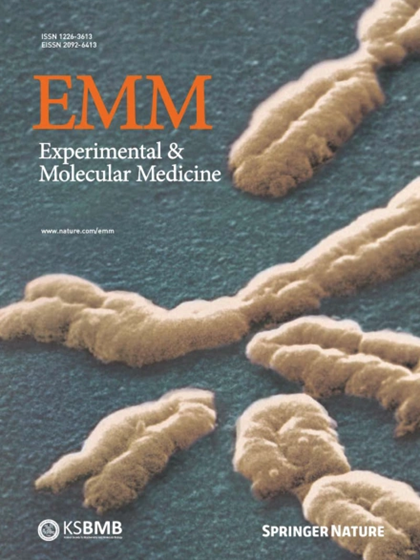A1AT dysregulation of metabolically stressed hepatocytes by Kupffer cells drives MASH and fibrosis
IF 9.5
2区 医学
Q1 BIOCHEMISTRY & MOLECULAR BIOLOGY
引用次数: 0
Abstract
Metabolic dysfunction-associated steatohepatitis (MASH) is associated with the activation of Kupffer cells (KCs) and hepatic stellate cells, at which point a metabolically stressed hepatocyte becomes integral to the progression of the disease. We observed a significant reduction in the level of alpha-1-antitrypsin (A1AT), a hepatocyte-derived secreted factor, in both patients with MASH and mice fed a fast-food diet (FFD). KC-mediated hepatic inflammation, most notably IL-1β, led to the transcriptional inhibition of A1AT by HNF4α. In quintuple Serpina1a–e knockout mice, ablation of A1AT worsened MASH through increased activity of proteinase 3 (PR3), a proinflammatory protease produced by F4/80hi/CD11blow/TIM4−/CCR2+ monocyte-derived KCs (MoKCs). Conversely, A1AT restoration or PR3 inhibition mitigated MASH progression. A PR3-bound cytokine array identified IL-32 as a key factor associated with MASH. Combining IL-32 with SERPINA1, the gene encoding A1AT, synergistically predicted patients at risk of MASH through univariate logistic regression analysis. Furthermore, in vivo overexpression of IL-32γ alleviated MASH induced by FFD. However, additional knockout of A1AT increased PR3 activity, consequently abolishing the anti-MASH effects of IL-32γ. Blocking PR3-mediated IL-32γ cleavage via the V104A mutation sustained its protective actions, while the PR3-cleaved C-terminal fragment activated KCs. Additionally, after cleavage, the antifibrogenic effect of IL-32γ is lost, resulting in a failure to prevent the activation of hepatic stellate cells. This study highlights the critical role of hepatocyte-derived A1AT in the PR3/IL-32γ axis during MASH development. Strategies to correct A1AT dysregulation, such as A1AT supplementation or PR3 inhibition with sivelestat, may offer protection against the development and progression of MASH and fibrosis. Metabolic dysfunction-associated steatotic liver disease (MASLD) is a major cause of liver failure worldwide. Researchers are trying to understand how it progresses to more severe conditions such as metabolic dysfunction-associated steatohepatitis (MASH). This study focuses on a protein called alpha-1-antitrypsin, which is important for liver health. The researchers used mice and human samples to study the role of A1AT in liver disease. They found that A1AT levels are lower in people and mice with MASLD, which leads to increased inflammation and liver damage. They also discovered that a protein called proteinase 3 becomes more active when A1AT is low, worsening the condition. By experimenting with mice, they showed that increasing A1AT or blocking PR3 can reduce liver damage. This suggests new treatment possibilities for MASH. The study concludes that targeting the A1AT/PR3 pathway could help manage liver disease progression. This summary was initially drafted using artificial intelligence, then revised and fact-checked by the author.

Kupffer细胞代谢应激肝细胞的A1AT失调驱动MASH和纤维化。
代谢功能障碍相关的脂肪性肝炎(MASH)与库普弗细胞(KCs)和肝星状细胞的激活有关,在这一点上,代谢应激的肝细胞成为疾病进展不可或缺的一部分。我们观察到,在患有MASH的患者和喂食快餐饮食(FFD)的小鼠中,α -1-抗胰蛋白酶(A1AT)水平显著降低,A1AT是一种肝细胞来源的分泌因子。kc介导的肝脏炎症,尤其是IL-1β,导致HNF4α对A1AT的转录抑制。在五倍Serpina1a-e基因敲除小鼠中,A1AT的消融通过增加蛋白酶3 (PR3)的活性使MASH恶化,PR3是一种由F4/80hi/CD11blow/TIM4-/CCR2+单核细胞源性KCs (MoKCs)产生的促炎蛋白酶。相反,A1AT恢复或PR3抑制可减轻MASH进展。pr3结合的细胞因子阵列鉴定出IL-32是与MASH相关的关键因子。通过单变量logistic回归分析,将IL-32与编码A1AT的基因SERPINA1结合,可协同预测患者的MASH风险。此外,体内过表达IL-32γ可减轻FFD诱导的MASH。然而,进一步敲除A1AT会增加PR3活性,从而消除IL-32γ的抗mash作用。通过V104A突变阻断pr3介导的IL-32γ切割维持其保护作用,而pr3切割的c端片段激活KCs。此外,在切割后,IL-32γ的抗纤维化作用丧失,导致无法阻止肝星状细胞的活化。这项研究强调了肝细胞来源的A1AT在MASH发展过程中在PR3/IL-32γ轴中的关键作用。纠正A1AT失调的策略,如补充A1AT或用西司他抑制PR3,可能对MASH和纤维化的发生和进展提供保护。MASH中肝脏IL-1β水平升高通过转录因子HNF4α导致A1AT下调,导致促炎MoKCs募集增加,PR3活性升高。PR3切割IL-32γ,将其从抗炎和抗纤维化的细胞因子转化为KCs的有效激活剂,而不能阻止HSC的激活。这种级联放大了肝脏炎症和纤维化,表明靶向A1AT/PR3/IL-32γ轴可能是治疗MASH的一种策略。
本文章由计算机程序翻译,如有差异,请以英文原文为准。
求助全文
约1分钟内获得全文
求助全文
来源期刊

Experimental and Molecular Medicine
医学-生化与分子生物学
CiteScore
19.50
自引率
0.80%
发文量
166
审稿时长
3 months
期刊介绍:
Experimental & Molecular Medicine (EMM) stands as Korea's pioneering biochemistry journal, established in 1964 and rejuvenated in 1996 as an Open Access, fully peer-reviewed international journal. Dedicated to advancing translational research and showcasing recent breakthroughs in the biomedical realm, EMM invites submissions encompassing genetic, molecular, and cellular studies of human physiology and diseases. Emphasizing the correlation between experimental and translational research and enhanced clinical benefits, the journal actively encourages contributions employing specific molecular tools. Welcoming studies that bridge basic discoveries with clinical relevance, alongside articles demonstrating clear in vivo significance and novelty, Experimental & Molecular Medicine proudly serves as an open-access, online-only repository of cutting-edge medical research.
 求助内容:
求助内容: 应助结果提醒方式:
应助结果提醒方式:


